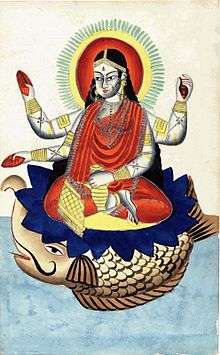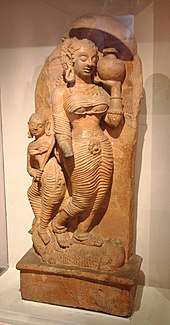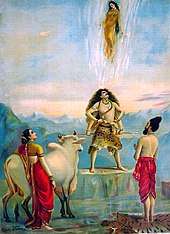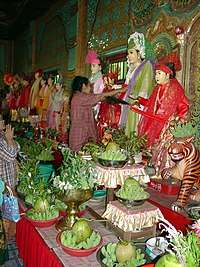Ganga in Hinduism
In Hinduism, the river Ganga is considered sacred and is personified as the goddess Gaṅgā. She is worshiped by Hindus and Buddhists who believe that bathing in the river causes the remission of sins and facilitates Moksha (liberation from the cycle of life and death), and that the water of the Ganges is considered very pure. Pilgrims immerse the ashes of their kin in the river Ganga, which is considered by them to bring the spirits closer to moksha.
| Ganga | |
|---|---|
Goddess of the Purity and Purification Personification of the Ganges River | |
 Goddess Ganga riding her mount Makara | |
| Other names | Bhagirathi, Jahnavi, Nikita, Jaahnukanya, Sapteshwari, Sureshwari, Bhagvati, Urvijaya, Chitraani, Tridhara, Bhaagirathi, Shubhra, Vaishnavi, Vishnupadi, Bhagvatpadi, Tripathaga, Payoshnika, Mahabhadra, Mandaakini, Meghna, Meghal, Gangika, Gange, Gangeshwari, Alaknanda |
| Affiliation | Devi, One of the 7 Holiest Rivers in Hinduism . |
| Abode | Brahma, Vishnu, Kailash, Gangotri |
| Mantra |
|
| Weapon | Trident, discus and kalasha |
| Mount | Makara |
| Festivals | Ganga Dussehra, Ganga Jayanti, and Navratri |
| Personal information | |
| Parents | Himavan and Menavati |
| Consort | lord Shiva |
| Children | Bhishma and Narmada |
| Equivalents | |
| Manipuri equivalent | Irai Leima |
Several places sacred to Hindus lie along the banks of the Ganges, including Gangotri, Haridwar, Prayagraj, Varanasi and Kali Ghat in Kolkata. During the Loy Krathong festival in Thailand, candlelit floats are released into waterways to honour Gautama Buddha and goddess Ganga for good fortune and washing away sins (pāpa in Sanskrit, used to describe actions that create negative karma by violating moral and ethical codes, which brings negative consequences).

Iconography
Ganga is described as the melodious, the fortunate, the cow that gives much milk, the eternally pure, the delightful, the body that is full of fish, affords delight to the eye and leaps over mountains in sport, the bedding that bestows water and happiness, and the friend or benefactor of all that lives.
Since time immemorial, the Ganga River has been considered the holiest of all rivers by Hindus. Ganga is also personified as a goddess and worshipped as Goddess Ganga. She holds an important place in the Hindu pantheon. Ganga is represented as a fair-complexioned woman, wearing a white crown and sitting on a crocodile. She holds a water lily in her right hand and a lute in her left. When shown with four hands she carries a water-pot, a lily, a rosary and has one hand in a protective mode. The Rig Veda mentions Ganga but more of her is said in the Puranas.
Ganga is depicted four-armed and mounted on a crocodile or enthroned surrounded by crocodiles. In one of iconography in Maha Virat-rupa she holds jar of amrita, rosary, lotus or shivalinga and varada mudra. She may be depicted in other ways holding only a kalash (or 2 replacing lotus) and lotus, while other 2 hands in varada and abhaya mudra. Another one shows her holding kalasha, trident, shivalinga and varada mudra.
Another depiction popular especially in Bengal shows her holding shankha , chakra (discus) , lotus and abhaya mudra , with Kalash releasing her holy water.
Crocodile or Makra as her vahana
In Brahma Vaivarta Purana, Ganga is often depicted with her divine vehicle, the Makara – an animal with the head of a crocodile and tail of a dolphin. The crocodile has meaningful symbolisms. The crocodile represents our reptilian brain telling us that we use our intellect to outgrow fear in facing problems. The Goddess not only faces her fear, but she uses it as a vehicle to move her forward on her path to greater growth, strength, and beauty. Fear is a natural reaction to moving closer to the truth. This vahana is symbolic of outgrowing and fracturing self-concepts, behaviors, situations to move closer to her highest form and to the highest truth. It is like shaking things up to remove the pieces that no longer serve a higher purpose and integrating new things that do.
Through her vahana, Ganga indicates an attribute to take a problem by the horns, as the crocodile plucks the prey from the banks of the river, takes the prey-problem deep in the water-flowing life, spins it until the prey-problem is disoriented- sees a solution. Crocodile eggs are indicative of human destiny. The reptile takes considerable time to build nests on the river banks in which to lay their eggs. Then again they leave, seemingly without concern of their effort and the impatience to see babies being born. This is what Divine does for you. Your birth may be your karma but there you are left to swim the river of life and face trials and tribulations which come as uncertainties.
Legend
Bhagavata Purana depicts the birth of the Ganga. According to the text, Vishnu in one of his incarnations appeared as Vaman in the sacrificial arena of Asur King Mahabali. Then in order to measure the universe, he extended his left foot to the end of the universe and pierced a hole in its covering with the nail of his big toe. Through the hole, the pure water of the Causal Ocean (Divine Brahm-Water) entered this universe as the Ganges River. Having washed the lotus feet of the Lord, which are covered with reddish saffron, the water of the Ganga acquired a very beautiful pink colour. Because the Ganges directly touches the lotus feet of Lord Vishnu (Narayana) before descending within this universe, it is known as Bhagavat-Padi or Vishnupadi which means Emanating from the lotus feet of Bhagavan (God). It finally settles in Brahmaloka or Brahmapura, abode of Lord Brahma before descending to planet Earth at the request of Bhagiratha and held safely by Lord Shiva on his head to prevent destruction of Bhumi Devi (Mother Earth). Then, Ganga was released from Lord Shiva's hair to meet the needs of the country according to Hinduism.
Descent to Earth

Several years later, a king named Sagara magically acquired sixty thousand sons. One day, King Sagara performed a ritual of worship for the good of the kingdom. One of the integral parts of the ritual was a horse, which was stolen by the jealous Indra. Sagara sent all his sons all over the earth to search for the horse. They found it in the nether-world (or Underworld) next to a meditating sage Kapil tied by Lord Indra (the king of Swarg). Believing that the sage had stolen the horse, they hurled insults at him and caused his penance to be disturbed. The sage opened his eyes for the first time in several years and looked at the sons of Sagara. With this glance, all sixty thousand were burnt to death.
The souls of the sons of Sagara wandered as ghosts since their final rites had not been performed. For the moksha of all the sons of Sagar, Anshuman (nephew of those 60,000 sons) started to pray Brahma to bring Ganga to the earth till the end of his life, but was not successful. Then his son Dilip did the same but did not succeed. When Bhagirathi(Means, one who does great hard work- he got his name from his great hard work for bringing Ganga to earth), one of the descendants of Sagara, son of Dilip, learnt of this fate, he vowed to bring Ganga down to Earth so that her waters could cleanse their souls and release them to heaven.
Bhagiratha prayed to Brahma that Ganga comes down to Earth. Brahma agreed and he ordered Ganga to go down to the Earth and then on to the nether regions so that the souls of Bhagiratha's ancestors would be able to go to heaven. Ganga felt that this was insulting and decided to sweep the whole Earth away as she fell from the heavens. Alarmed, Bhagiratha prayed to Shiva that he break up Ganga's descent.
Ganga arrogantly fell on Shiva's head. But Shiva calmly trapped her in his hair and let her out in small streams. The touch of Shiva further sanctified Ganga. As Ganga traveled to the nether-worlds, she created a different stream to remain on Earth to help purify unfortunate souls there. She is the only river to follow from all the three worlds – Swarga (heaven), Prithvi (Earth) and Patala (netherworld or hell). This is called Tripathagā(one who travels the three worlds) in Sanskrit language.
Because of Bhagiratha's efforts, Ganga descended to Earth and hence the river is also known as Bhagirathi and the term Bhagirath prayatna is used to describe valiant efforts or difficult achievements.
Another name that Ganga is known by is Jahnavi, Story has it that once Ganga came down to Earth, on her way to Bhagiratha, her rushing waters created turbulence and destroyed the fields and the sadhana of a sage called Jahnu. He was angered by this and drank up all of Ganga's waters. Upon this, the Gods prayed to Jahnu to release Ganga so that she could proceed with her mission. Pleased with their prayers, Jahnu released Ganga (her waters) from his ears. Hence the name Jahnavi(daughter of Jahnu) for Ganga.
It is sometimes believed that the river will finally dry up at the end of Kali Yuga, the last of the four stages the world goes through as part of the cycle of yugas (the era of darkness, the current era) just as with the Sarasvati river and this era will end. Next in(cyclic) order will be the Satya Yuga or the era of Truth.
Consort and mother
_to_his_father%2C_Santanu..jpg)
Ganga married Shantanu in Mahabharata. According to shiva purana, Ganga married Shiva. Some scriptures says, Shantanu married an incarnation/human form of Ganga but not actual Goddess Ganga.
The Ganga is also the mother, the Ganga Mata (Mata="mother") of Hindu worship and culture, accepting all and forgiving all.[1] Unlike other goddesses, she has no destructive or fearsome aspect, destructive though she might be as a river in nature.[1] She is also a mother to other gods.[2] In the Mahabharata, she is the wife of Shantanu, and the mother of heroic warrior-patriarch, Bhishma.[2] When Bhishma is mortally wounded in battle, Ganga comes out of the water in human form and weeps uncontrollably over his body. Bhishma brought about his own downfall by abducting and disgracing a princess named Amba whose only wish was to be married.[2]
The Ganga is the distilled lifeblood of the Hindu tradition, of its divinities, holy books, and enlightenment.[3] As such, her worship does not require the usual rites of invocation (avahana) at the beginning and dismissal (visarjana) at the end, required in the worship of other gods.[3] Her divinity is immediate and everlasting, but only for as long as the river survives.[3]
Rigveda
Ganga is mentioned in the Rig Veda, the earliest and theoretically the holiest of the Hindu scriptures. Ganga is mentioned in the nadistuti (Rigveda 10.75), which lists the rivers from east to west. In RV 6.45.31, the word Ganga is also mentioned, but it is not clear if the reference is to the river.
RV 3.58.6 says that "your ancient home, your auspicious friendship, O Heroes, your wealth is on the banks of the Jahnavi(JahnAvyAm)". This verse could possibly refer to the Ganga. In RV 1.116.18–19, the Jahnavi and the Ganga River Dolphin occur in two adjacent verses.
Festivals
Ganga Jayanti
On this day Ganga was reborn. Legend says on her way during her descent to earth she by mistake destroyed the hut of sage jhanu. As a consequence the sage drank all her water. On request by bagirath and Ganga maa herself he released Ganga from his ear and she earned the name Jahanvi. It falls on Saptami of Vaishakh month's shukla paksha.
Navratri
Ganga Maa is worshipped during Navratri as all the forms of Maa Adishakti are worshipped in those days.
Loi Krathong
Thais use the krathong to thank the Goddess of Water, the Hindu Goddess Ganga, Phra Mae Khongkha (Thai: พระแม่คงคา).
Ganga Talao
Ganga Talao in Mauritius is considered by the Mauritian Hindus equivalent to Ganga.In 1972,the then Prime Minister of Mauritius, Sir Seewoosagur Ramgoolam brought Holy water from the Ganga from Gomukh in India and mixed it with the water of Grand Bassin and renamed it as Ganga Talao.[4]
See also
References
- Quoted in Eck 1982, p. 218
- Eck 1998, p. 149
- Eck 1982, p. 219
- "How a lake became the sacred Ganga Talao". Retrieved 5 March 2020.
Sources
- Eck, Diana L. (1982), Banaras, city of light, Columbia University, ISBN 978-0231114479, retrieved 26 July 2011CS1 maint: ref=harv (link)
- Eck, Diana (1998), "Gangā: The Goddess Ganges in Hindu Sacred Geography", in Hawley, John Stratton; Wulff, Donna Marie (eds.), Devī: Goddesses of India, University of California / Motilal Banarasidass, pp. 137–53, ISBN 8120814916CS1 maint: ref=harv (link)
- Vijay Singh: The River Goddess (Moonlight Publishing, London, 1994)
External links
| Wikimedia Commons has media related to Ganga. |
| Wikiquote has quotations related to: Ganga in Hinduism |
- The Life Of Ganga
- Ganga Ma: A Pilgrimage to the Source a documentary that follows the Ganges from the mouth to its source in the Himalayas.
